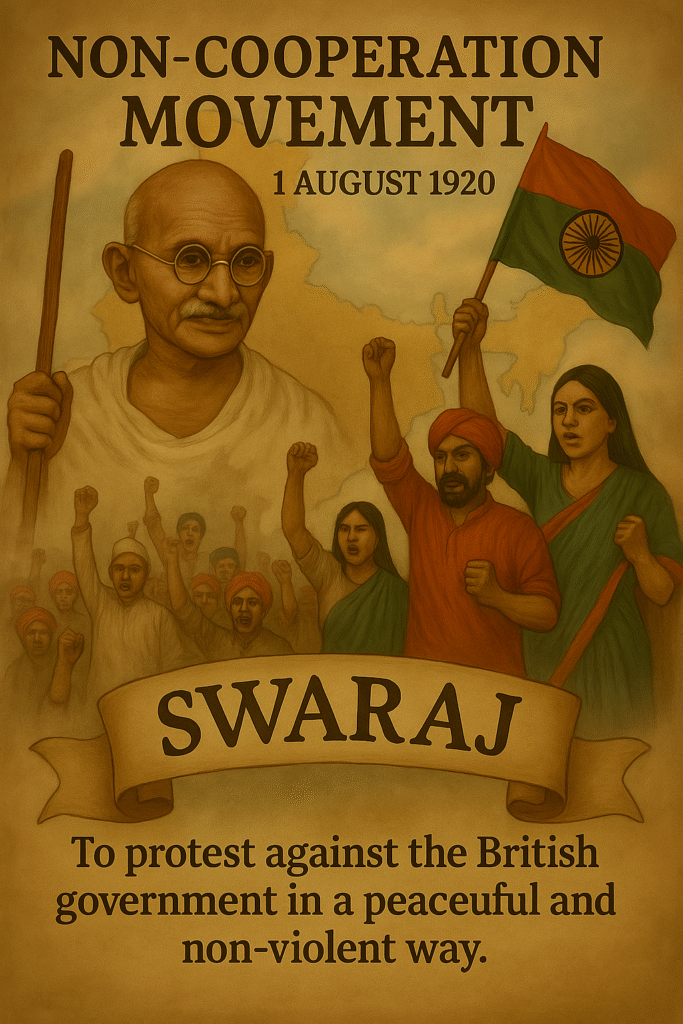
Cooperation Movement was an important phase of the Indian freedom struggle , which was started by Mahatma Gandhi on 1 August 1920. Its purpose was to protest against the British government in a peaceful and non-violent way so that India could achieve Swaraj (self-rule). Through this movement, the Indian people were inspired to non-cooperate with the British rule.
Reasons for the Non-Cooperation Movement:
- Jallianwala Bagh Massacre ( 1919): This brutal massacre created anger among the Indian public.
- Rowlatt Act ( 1919): This law allowed arrests without trial , which caused discontent across the country.
- Khilafat Movement: The movement started in support of Caliph , which inspired Gandhiji for Hindu-Muslim unity.
- Discontent against British Policies: Heavy taxes , discriminatory administrative policies , and economic exploitation were also major reasons.
Main objectives of the Non-Cooperation Movement:
- Complete non-cooperation towards British rule.
- Boycott of government jobs , courts , schools and foreign clothes.
- To promote Indian institutions and indigenous products.
- Public awakening and non-violent protest for attainment of Swaraj.
Main events:
- Resignation from government posts: Resignation from educational institutions , government jobs , and legislatures.
- Boycott of foreign clothes: Foreign clothes were burnt and Khadi clothes were adopted.
- Swadeshi Movement: Swadeshi goods and industries were encouraged.
- Support of farmers and workers: Especially in Bihar , Uttar Pradesh , Punjab , and Bengal, farmers protested against paying taxes.
Chauri Chaura Incident ( 1922):
In Chauri Chaura in Gorakhpur, the protesters set fire to the police station , killing several policemen. Shocked by this violent incident, Gandhiji suddenly called off the movement as he was against any kind of violence.
Results and Impact:
- Even though the movement was postponed , it gave a new direction to the Indian freedom struggle.
- Self-confidence arose among the people and the idea of swaraj became stronger.
- Gandhiji established himself as a national leader.
- The British government started fearing the unity and awareness of the Indian people.
conclusion:
The Non-Cooperation Movement was a milestone in the Indian freedom struggle. It widely spread political consciousness in India and strengthened the principle of non-violence. Even though this movement could not achieve its goal completely , it strengthened the foundation of independence even more.
Reasons For The Non-Cooperation Movement
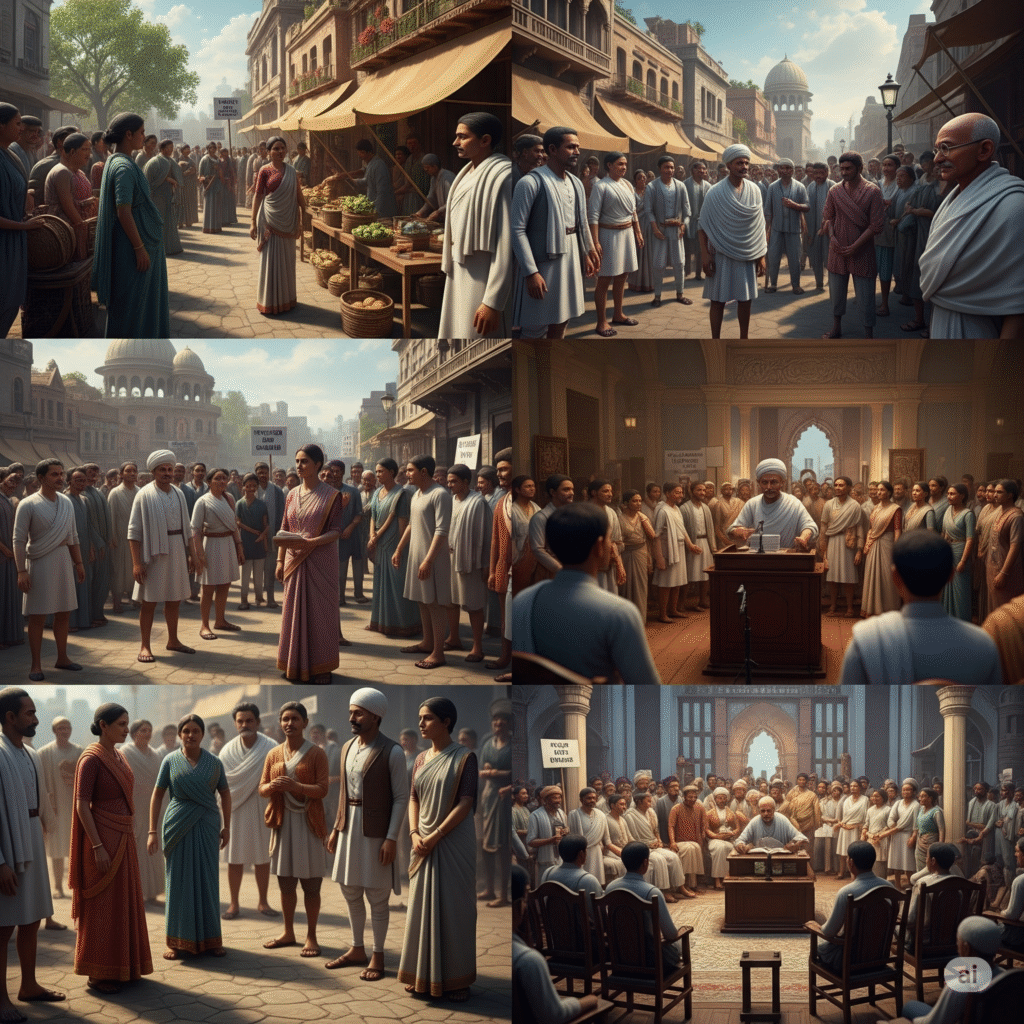
Main reasons of non-cooperation movement:
The Non-Cooperation Movement was started in 1920 under the leadership of Mahatma Gandhi. There were many important social , political , economic , and religious reasons behind this movement , which inspired the Indian people to unite against the British rule. Let us understand these reasons in detail:
1️ ⃣ Jallianwala Bagh Massacre ( 1919):
- Incident: On April 13 , 1919, thousands of innocent people were holding a peaceful meeting at Jallianwala Bagh in Amritsar.
- General Dyer’s Massacre: On the orders of General Reginald Dyer, the troops opened fire on the unarmed people , killing hundreds and injuring thousands.
- Effect: This massacre created deep resentment in the whole country and increased hatred towards the British rule. The trust of the Indian public in the British government was completely broken.
2️ ⃣ Rowlatt Act ( 1919):
- Purpose of the law: The British government allowed arrest without warrant and imprisonment without trial in the country through the “Rowlatt Act”.
- Public protest: There were widespread protests all over the country against this black law. Gandhiji called it a “black law” and launched a Satyagraha movement against it.
- Effect: This law created the belief among Indians that the British government was the enemy of justice and freedom.
3️ ⃣ Khilafat Movement ( 1919-1924):
- background: After the First World War, the Turkish Caliph , who was considered the religious leader of the Muslims , was deposed.
- Opposition from Indian Muslims: Indian Muslims considered this an insult to Islam and launched the Khilafat Movement.
- Hindu-Muslim Unity: Gandhiji supported the Khilafat Movement to strengthen Hindu-Muslim unity and linked it with the Non-cooperation Movement.
4️ ⃣ British Exploitative Policies and Economic Crisis:
- Economic Exploitation: The British government imposed heavy taxes on Indian peasants , labourers and traders and suppressed Indian industries.
- Poverty and Unemployment: British rule weakened the Indian economy , leading to increased poverty , hunger, and unemployment.
- Destruction of Indigenous Industries: British textiles and products caused losses to Indian artisans and traders.
5️ ⃣ Effects of First World War ( 1914-1918):
- Sacrifice of Indians: Millions of Indian soldiers fought for the British Army , but in return they did not get any political or social rights.
- Post War Difficulties: After the war, problems like inflation , food crisis , and epidemic made the condition of the people even worse.
6️ ⃣ Gandhiji’s leadership and impact of Satyagraha:
- Gandhiji’s Appeal: The principle of truth and non-violence under the leadership of Mahatma Gandhi attracted the people.
- The idea of non-violent non-cooperation: Gandhiji assured that the British government can be subdued through non-violence. This infused new energy in the people.
conclusion:
The Non-Cooperation Movement was born out of a combination of various political , social , economic and religious reasons. The Jallianwala Bagh massacre , the Rowlatt Act , the Khilafat Movement , British exploitation , and Gandhiji’s influence awakened a strong desire for independence in the minds of Indians. This movement proved to be an important step towards independence.
Main Objectives of The Non-Cooperation Movement
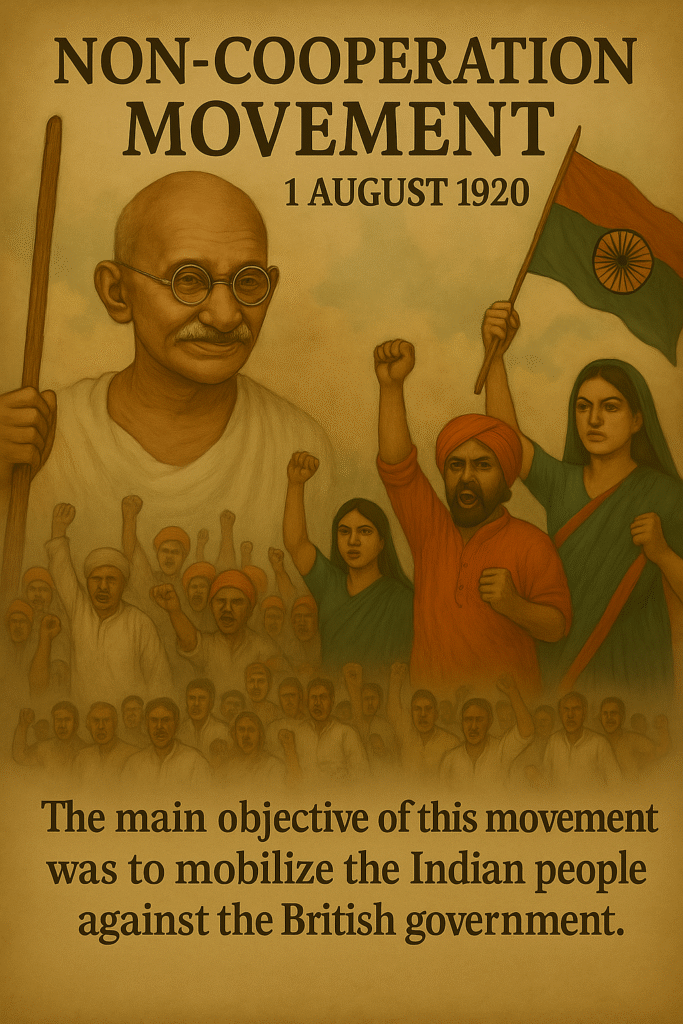
Main Objectives of Non-Cooperation Movement:
The Non-Cooperation Movement was started on 1 August 1920 under the leadership of Mahatma Gandhi. The main objective of this movement was to mobilize the Indian people against the British government. Non-violent non-cooperation so that India could be united through Swaraj ( Self-Rule) This movement gave a new direction to the Indian freedom struggle and made the people aware of their rights.
Let us understand the main objectives of the Non-Cooperation Movement in detail:
1️ ⃣ Attainment of Self- Rule :
- Main goals: The most important objective of the movement was to end British rule and establish Swaraj in India.
- Mahatma Gandhi’s belief: Gandhiji believed that if the Indian people stopped all types of cooperation with the British rule , the British government would weaken and India would get Swaraj.
- Target Deadline: Gandhiji claimed that if the non-cooperation movement was successful then India could achieve Swaraj within a year.
2️ ⃣ Non-Cooperation with British Rule :
- Political non-cooperation: Government jobs , courts , and assemblies were boycotted.
- Academic Non-Cooperation: National educational institutions were established by boycotting government schools , colleges , and universities.
- Legal non-cooperation: Lawyers stopped practising in British courts.
- Economic non-cooperation: Foreign clothes and products were boycotted to harm British economic interests .
3️ ⃣ Support for the Khilafat Movement:
- Khilafat issue: Another objective of the movement was to support the Muslim community’s protest against the removal of the Turkish Caliph.
- Hindu-Muslim Unity: Gandhiji tried to strengthen Hindu-Muslim unity by linking the Khilafat Movement with the Non-Cooperation Movement. This got the support of both the communities in the Indian freedom struggle.
4️ ⃣ Applying the principle of non-violence and Satyagraha:
- Non-violent protests: One of the main objectives of the movement was to protest against the unjust laws and policies of the British government through non-violent means.
- Practice of Satyagraha: To make the movement peaceful and morally strong on the basis of the principles of truth and non-violence .
5️ ⃣ Promotion of Swadeshi goods and boycott of foreign clothes:
- Expansion of the Swadeshi Movement: To encourage indigenous products and industries so as to strengthen the Indian economy.
- Boycott of foreign clothes: To weaken the British government economically by prohibiting the sale and use of British textiles and products.
- Promotion of Khadi: Gandhiji made wearing Khadi a symbol of self-reliance and patriotism.
6️ ⃣ Development of self-respect and national consciousness among the Indian people:
- Sense of self-esteem: The aim of the movement was to instill a feeling in the minds of Indians that they can stand up for their rights.
- National awareness: An attempt was made to convince the Indian people that independence was their birthright and it could be achieved through non-violent means.
7️ ⃣ Protecting the rights of farmers and workers:
- Support to farmers: Farmers were made aware against excessive taxes and exploitation.
- Labour Movement: Workers were also organised to fight the exploitation by British capitalists.
conclusion:
The aim of the non-cooperation movement was not only to oppose the British rule but also to make the Indian society self-reliant , aware and organized. This movement brought unity among the Indian people. Swaraj , non-violence , and Nationalism Was successful in strengthening the values of.
Major Events of Non-Cooperation Movement
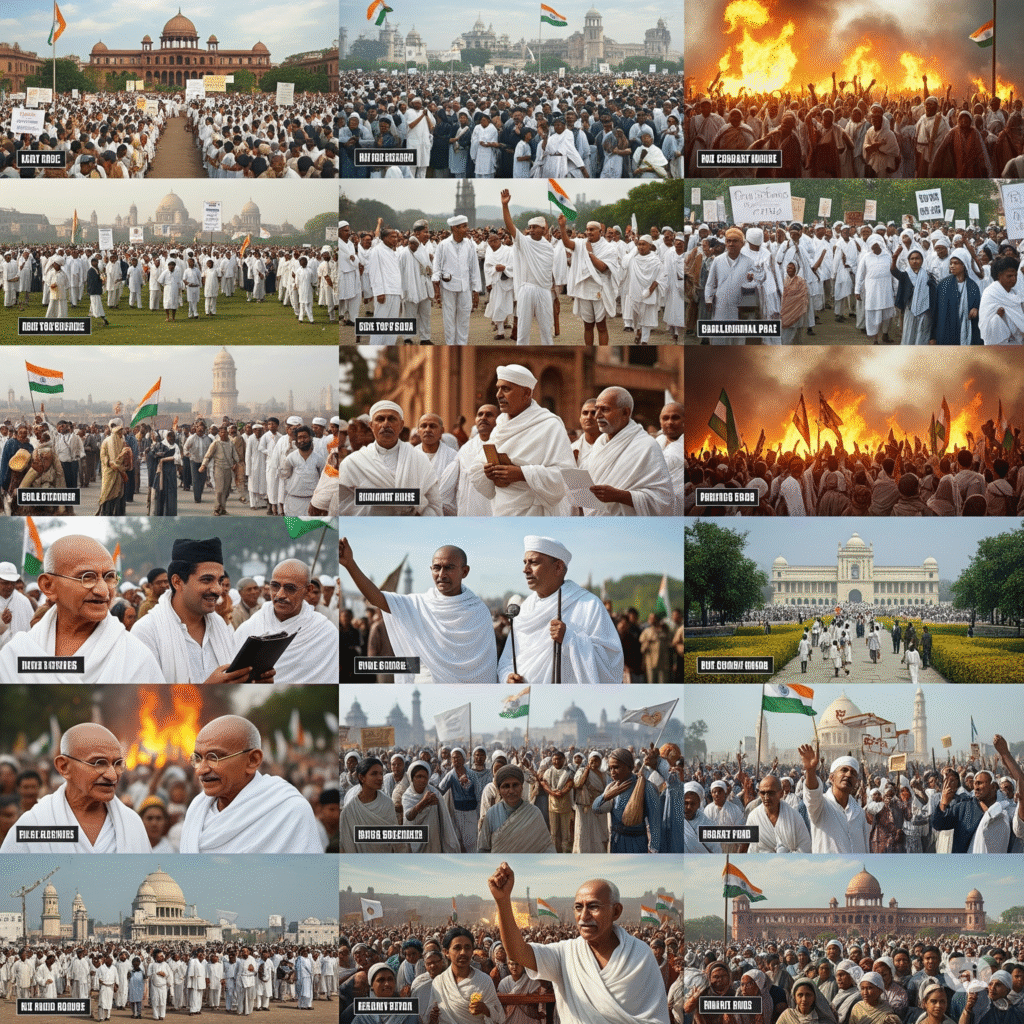
Major Events of Non-Cooperation Movement:
During the Non-Cooperation Movement ( 1920-1922) many important events took place all over India , which gave this movement a mass movement These events led to widespread protests against British rule and gave a new direction to the Indian freedom struggle. Let us understand these major events in detail:
1️ ⃣ Resignation from Government Positions :
- Nature of the event: On the call of Mahatma Gandhi, Indian leaders , teachers , and officials started resigning from their positions under the British government.
- Prime example:
- Motilal Nehru And Chittaranjan Das Like prominent leaders resigned from their prestigious posts.
- government jobs , advocacy , and administrative positions also stopped cooperating with the British rule.
- Effect: This raised questions about the legitimacy of the British administration and the government machinery began to weaken. The government had to resort to external sources to reduce its dependence on Indians.
2️ ⃣ Boycott of Foreign Goods:
- Nature of the event: British manufactured clothes and products were openly boycotted during the Non-Cooperation Movement.
- Holi of foreign clothes: The Indian public burnt foreign clothes , especially in big cities like Bombay (Mumbai) , Calcutta (Kolkata) , and Ahmedabad In.
- Effect:
- Sales of British textiles fell sharply.
- The Indian textile industry , especially the Khadi and handloom industries, got a new life.
- Wearing indigenous clothes became a symbol of nationalism.
3️ ⃣ Promotion of Swadeshi Movement :
- Nature of the event: During the Non-Cooperation Movement Swadeshi Movement was also encouraged. Gandhiji called upon the people to give up foreign clothes and products and adopt swadeshi goods.
- Importance of Khadi:
- Gandhiji made Khadi a symbol of self-reliance and promoted it by spinning the spinning wheel himself.
- Wearing khadi became a political and cultural symbol of the independence movement.
- Development of local industries: Cottage industries , handicrafts , and local trade were boosted, strengthening the rural economy.
- Effect: The Swadeshi movement instilled a sense of self-reliance among Indians and reduced dependence on foreign goods.
4️ ⃣ Support for Farmers and Workers :
- Farmers’ Movement:
- During the Non-Cooperation Movement, farmers raised their voice against excessive taxes , eviction , and landlord exploitation by the British government.
- Awadh (Uttar Pradesh) In Baba Ramchandra Under the leadership of farmers started a movement of not paying taxes.
- Champaran of Bihar In 1830, Gandhiji led a successful Satyagraha in support of the farmers against indigo cultivation.
- Workers’ Movement:
- The working class held strikes against low wages , poor working conditions , and exploitation by British capitalists.
- Mill workers of Ahmedabad went on strike under the leadership of Gandhiji and fought for their rights.
- Effect:
- The movement of peasants and labourers spread the non-cooperation movement at the rural and industrial level.
- Political awareness and consciousness of rights came among the farmers and labourers.
- British rule suffered economically and administratively.
Important effects:
- These incidents made the Indian people realize that to weaken the British government not only arms but also Organised non-cooperation and non-violence is also required.
- All over the country feeling of nationalism It strengthened and the Indian independence movement gained new momentum.
conclusion:
These major events of the Non-Cooperation Movement gave a new direction to the Indian freedom struggle. Resignation from government posts , boycott of foreign clothes , Swadeshi movement , and Support of farmers and workers It shook the roots of British rule and organized the Indian people for independence. Even though this movement was suspended in 1922 , it awakened a new consciousness among Indians to fight for independence.
Chauri Chaura Incident ( 1922)
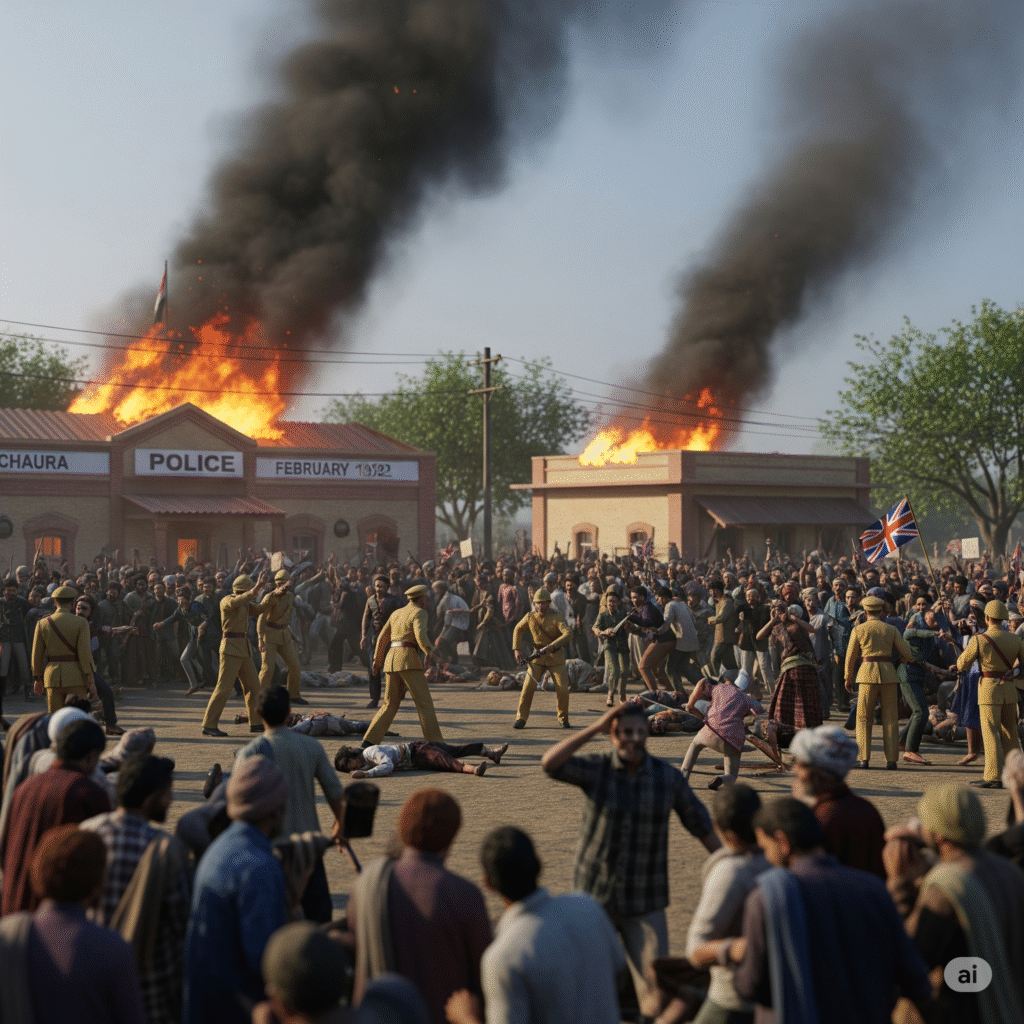
Detailed description of Chauri Chaura incident ( 1922)
Chauri Chaura incident This is an important event in the history of Indian freedom struggle. This event took place on 4 February 1922 in Gorakhpur district of Uttar Pradesh. Chauri Chaura This incident happened at a place called. Due to this incident Mahatma Gandhi Non-cooperation movement was suddenly postponed , which brought a new turn in the Indian freedom struggle.
Let us understand this phenomenon in detail:
📍 1️ ⃣ Background of the Incident :
- Impact of Non-Cooperation Movement: Under the Non-Cooperation Movement started in 1920 , protests were taking place all over the country against the British government.
- Farmers’ resentment: Peasants in the Chauri Chaura area were troubled by excessive taxes , exploitation , and police excesses.
- Police repression: The British police were using excessive force against the protesters , which was increasing public anger.
⚡ 2️ ⃣ The Main Incident of Chauri Chaura ( 4 February 1922):
- Peaceful demonstration: On 4 February 1922 , thousands of villagers took out a peaceful procession in Chauri Chaura. They were trying to close the local market and government offices as part of the non-cooperation movement.
- Police Brutality: During the procession, the British police lathi-charged and opened fire on unarmed protesters , killing several people.
- Public outrage: The angry mob retaliated after the police brutality. The angry mob surrounded the police station and set it on fire.
- Death of policemen: in this fierce fire 23 British policemen were burnt alive.
🚩 3️ ⃣ Main Causes of the Incident:
- Repression by British Police: Excessive use of force and firing on peaceful protesters.
- Farmers’ resentment: Anger against economic exploitation , heavy taxes , and oppression of landlords.
- Intensity of the Non-Cooperation Movement: The impact of the movement awakened a feeling of self-confidence and resistance among the people.
- The indifference of the administration: The policies and administrative harshness of the British government further fuelled public anger.
🚨 4️ ⃣ Gandhiji’s Reaction :
- Non-cooperation movement suspended: Gandhiji found this incident extremely sad because the aim of the movement was non-violence. He called it a ” Violation of the principle of non-violence” Agreed.
- Movement withdrawn: Gandhiji suddenly suspended the Non-Cooperation Movement on 12 February 1922 , leaving many leaders and supporters disappointed.
- Arrest of Gandhiji: Shortly after this verdict, Gandhiji was also arrested and sentenced to 6 years imprisonment (though he was released in 2 years).
⚡ 5️ ⃣ Consequences of Chauri- Chaura Incident :
- End of the Non-Cooperation Movement: This incident led to the end of the Non-cooperation Movement , dealing a major blow to the freedom struggle.
- Gandhiji’s emphasis on non-violence: Gandhiji made it clear that the struggle for freedom was not only the path of non-violence But only then can one proceed further.
- Political divisions: Several leaders (such as Subhash Chandra Bose And Bhagat Singh found this decision of Gandhiji to be a weak strategy and he adopted a different path.
- Strict action by the British Government: British Administration took strict measures after this incident and almost 225 people arrested to be done.
- Capital punishment: 19 people found guilty in the Chauri Chaura incident were sentenced to death and many others were sentenced to life imprisonment.
📜 6️ ⃣ Historical Significance of Chauri Chaura incident :
- This event gave impetus to the freedom struggle Non-violent and revolutionary currents started a new debate between.
- The Chauri Chaura incident taught us that How difficult it is to control the energy of the masses This happens , especially when the movement becomes widespread.
- This incident is a milestone in the history of freedom struggle. turn was made , where Gandhiji made it clear that ” Non-violence is our greatest weapon.”
🎯 7️ ⃣ Conclusion : The Chauri Chaura incident was not only a tragic event but it changed the direction and strategy of the Indian freedom movement. This incident was a major factor in Gandhiji’s Non-violence principle became a test of the freedom struggle Discipline and restraint highlighted the importance of.
Results and Impact
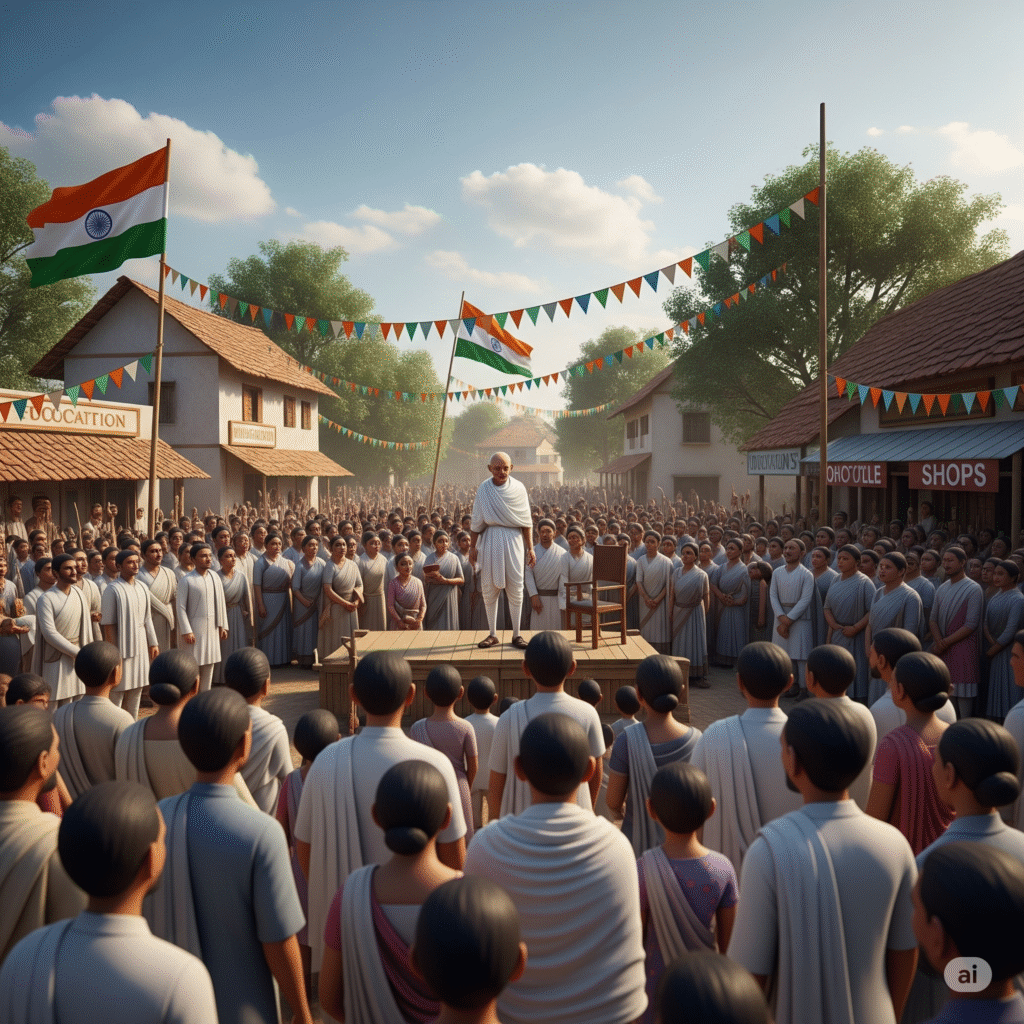
Results and Impact of Non-Cooperation Movement :
Non-cooperation Movement ( 1920–1922) This is an important chapter of the Indian freedom struggle. This movement brought about a change in Indian society political awareness , national integration , and Nonviolence Although this movement could not immediately achieve its declared objective (attainment of Swaraj) , its far-reaching results and impact were extremely important for the Indian freedom struggle.
Let us discuss about the non-cooperation movement Results and impact Let’s understand in detail:
🎯 1️ ⃣ Political Results :
- Suspension of the Non-Cooperation Movement: Due to the violence in
the Chauri-Chaura incident ( 1922) , Mahatma Gandhi suddenly suspended the movement. This disappointed many leaders and workers. - British Government’s Reaction:
The government took strict measures to suppress the movement. Thousands of people were arrested , including Mahatma Gandhi , Motilal Nehru , and Lala Lajpat Rai Prominent leaders like were also included. - Direction of non-violent movement:
Gandhiji made it clear that in future movements only Non-violent protests This will be the main strategy.
🌍 2️ ⃣ Social Impact :
- National Integration:
The Non-Cooperation Movement Hindu-Muslim Unity Strengthened the , especially through support for the Khilafat Movement. - Social awareness:
among the general public National consciousness And a sense of revolt against British rule developed. - Participation of Women:
Women also participated actively in this movement , making their role important in the Indian independence movement.
📚 3️ ⃣ Educational Impact :
- Boycott of Government Education:
Students boycotted British Government schools and colleges and National Educational Institutions As Jamia Millia Islamia And Kashi Vidyapeeth was established. - Independent Education System:
In Indian Education System Indigenous thinking And Nationalistic values was spread.
💼 4️ ⃣ Economic Impact :
- Boycott of foreign clothes:
British clothes and products were boycotted , causing huge losses to British trade. - Development of indigenous industries:
Indian industries , especially Khadi And cottage industries were promoted , which encouraged economic self-reliance. - Decrease in British Revenue:
The boycott of foreign clothes and protest against taxes led to a decline in the revenue of the British government.
👥 5️ ⃣ Impact on Farmers and Workers :
- Support to Farmers:
Farmers took part in movements against landlords and British tax policy , which increased awareness of their rights. - Expansion of labour movements:
Workers also carried out strikes and protests against their exploitation , which gave a new direction to the labour movements.
⚡ 6️ ⃣ Reasons for Movement’s Failure :
- Chauri Chaura incident: Due to the violent incident Gandhiji had to withdraw the movement.
- lack of discipline: There was a lack of discipline and commitment to non-violence among the participants in the movement.
- British Oppression: The British government took strict repressive measures against the protesters.
🚩 7️ ⃣ Long- Term Impact :
- Foundation of non-violent movements:
The Non-Cooperation Movement later Civil Disobedience Movement ( 1930) And Quit India Movement ( 1942) prepared the way for. - Development of political leadership:
Many new leaders emerged during this movement , such as Jawaharlal Nehru , Subhash Chandra Bose , etc. - Consciousness of Independence:
Even though the movement was unsuccessful , it made the dreams of Indians for independence even stronger.
📌 8️ ⃣ Conclusion : The non-cooperation movement was a major part of the Indian freedom struggle Historical turning point It proved to be a political awareness , national integration , and Non-violent protests This deeply established the spirit of revolt. As a result of the movement , the Indian people became more organised and self-confident against British rule.
Reference
Bipan Chandra. India’s Struggle for Independence (1857–1947). Penguin Books, 1988.
Sumit Sarkar. Modern India (1885–1947). Macmillan, 1983.
Sekhar Bandyopadhyay. From Plassey to Partition and After: A History of Modern India. Orient BlackSwan, 2015.
R. C. Majumdar. History of the Freedom Movement in India. Firma KLM, 1962.